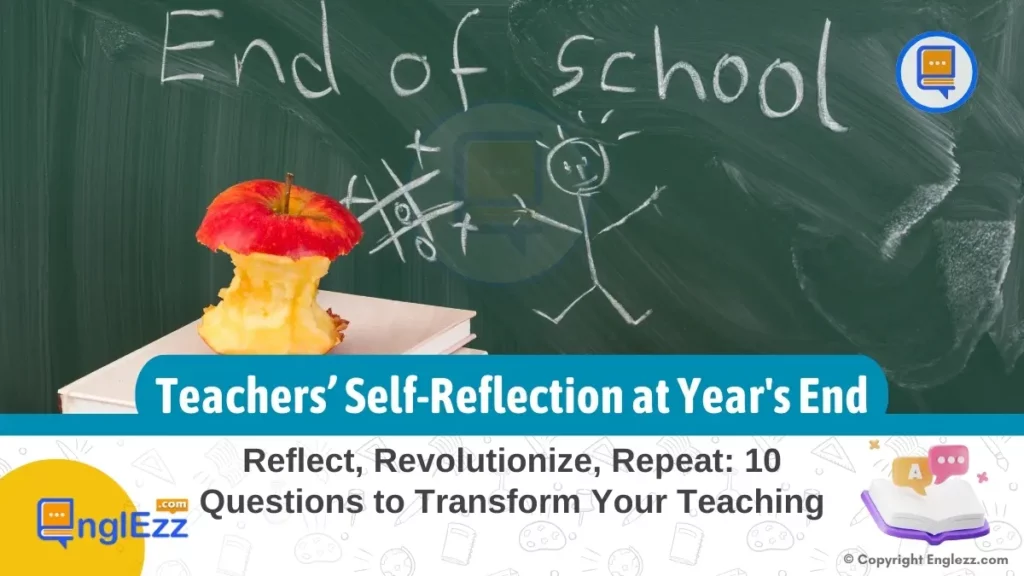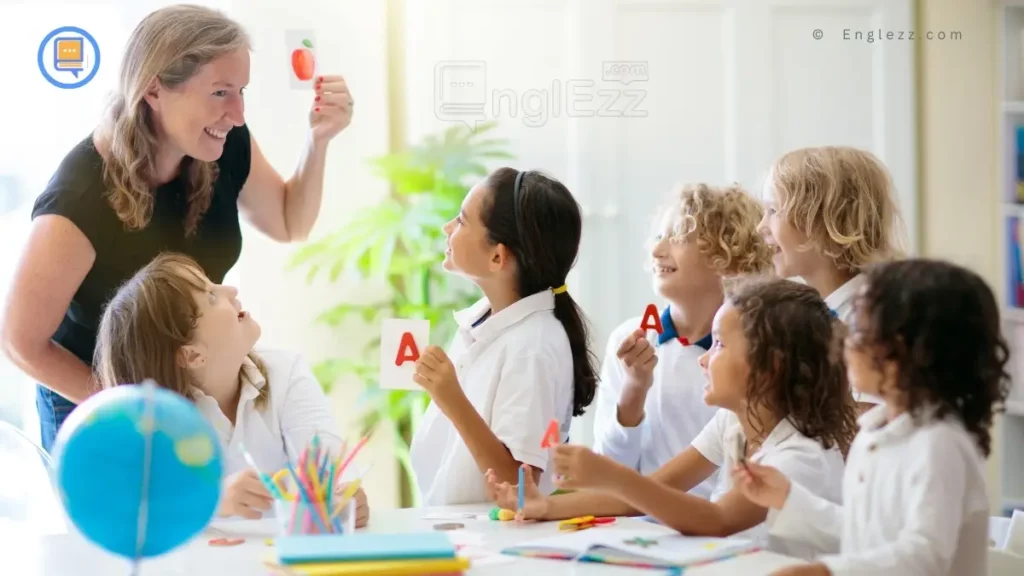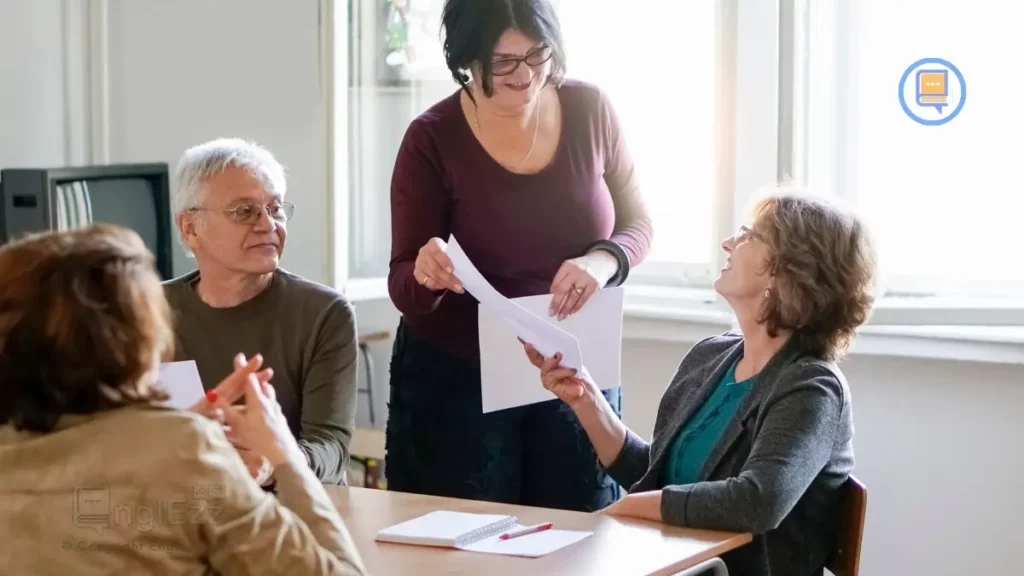Stepping into the realm of education is a journey filled with milestones, challenges, and moments of profound impact. As educators, we are not just purveyors of knowledge; we are the architects of futures yet to unfold. Empower your teaching journey with our top 10 self-reflection prompts for teachers. Gain insights and renew your passion!
At the crossroads where reflection meets transformation, lies an opportunity for growth and evolution in our teaching practices. With a compass forged from introspection and guided by curiosity, we invite you to join us on a voyage of self-discovery – a voyage that promises to illuminate new pathways towards excellence.
Top 10 Self-Reflection Prompts for Teachers at Year’s End
In the ever-evolving landscape of education, adaptation becomes our ally, and innovation our guiding star. Recognizing the importance of continuous improvement, we present a roadmap etched with ten illuminating questions crafted to ignite your spirit of inquiry and elevate your pedagogical prowess.

From navigating the intricate dance of classroom management to fostering meaningful relationships with students and parents; from honing assessment strategies like a master artisan to nurturing your own well-being amidst the whirlwind of academia – these questions serve as beacons in the sea of endless possibilities. Join us as we embark on a quest for enlightenment through self-reflection, armed with resilience, curiosity, and an unwavering commitment to transform teaching paradigms. Let’s delve deep into the tapestry of our experiences, unraveling threads of insight that weave together a tapestry of profound educational growth.
As seasons change and school bells mark year’s end, let us not merely close chapters but author new beginnings infused with wisdom gleaned from mindful contemplation. Together, let’s embark on this transformative odyssey where every question asked is a spark igniting a flame of innovation – where every reflection shared is a stepping stone towards reinventing our roles as educators in shaping minds and hearts. The voyage begins here; will you chart this course alongside us? Embark on this journey where self-reflection blooms into revolutionizing change—empowering teachers to transcend limits and reimagine educational horizons anew.
Analyzing Classroom Management
As the school year draws to a close, it’s an opportune moment for educators to pause and reflect on their classroom management practices. By looking back at the strategies implemented throughout the year, teachers can assess what worked well, what could be improved, and what innovations may better suit their students’ needs. Reflecting on current techniques is crucial not only for maintaining order and discipline but also for fostering student engagement and creating a positive learning environment.
One approach to enhance classroom management is by considering adjustments or innovations based on student dynamics and feedback. For instance, if a certain group of students responded positively to a particular management style or incentive system, analyzing why it was effective can provide valuable insights for future implementations. Additionally, receiving feedback directly from students about what strategies they found most helpful or engaging can guide teachers in refining their approaches to better suit the class dynamic.

Positive reinforcement techniques play a pivotal role in shaping student behavior and attitudes towards learning. By exploring different methods of positive reinforcement—such as verbal praise, rewards systems, or acknowledgment of effort—teachers can cultivate a supportive atmosphere that motivates students to excel.
Understanding the impact of these techniques on student behavior enables educators to tailor their reinforcement strategies effectively, reinforcing desired behaviors while nurturing a growth mindset among learners. Ultimately, by reflecting on classroom management practices through the lens of effectiveness and engagement, teachers can pave the way for more impactful and harmonious learning experiences in the future.
Evaluating Assessment Strategies
Assessment strategies play a pivotal role in shaping the educational experience for both teachers and students. As the academic year draws to a close, it is essential for educators to reflect on the effectiveness of their assessment methods. By reviewing the various tools and techniques used for assessment throughout the year, teachers can gain valuable insights into what worked well and where improvements are needed. For example, consider the impact of incorporating more project-based assessments to allow for creativity and critical thinking skills development beyond traditional tests.
Aligning assessments with learning objectives is key to ensuring that student progress is effectively measured. As teachers analyze the correlation between what students were expected to learn and how that learning was assessed, they can pinpoint areas where adjustments are necessary. Reflecting on whether assessments truly capture the depth of knowledge and skills students have acquired enables educators to fine-tune their evaluation methods for greater accuracy. This alignment ensures that assessments not only measure student understanding but also drive instructional decisions moving forward.
Moreover, an evaluation of formative and summative assessments is crucial in determining their efficacy in providing meaningful feedback and measuring overall student growth. Teachers can reflect on how formative assessments helped guide instruction in real-time while considering the impact of summative assessments on gauging long-term learning outcomes. For instance, reflecting on moments when formative assessments informed instructional modifications based on immediate student needs showcases the value of ongoing feedback loops in enhancing teaching practices. By understanding which assessment types best serve different purposes, educators can tailor their approach to meet diverse learner needs effectively.
Strengthening Relationships with Students and Parents
When looking back on the academic year, assessing communication channels with students and parents is a critical aspect of cultivating a thriving educational environment. Reflecting on your approaches to building trust and rapport with diverse student populations can uncover insights into what worked well and areas that may need improvement. For example, hosting regular parent-teacher conferences, sending out newsletters or updates on student progress, or utilizing digital platforms for communication can enhance collaboration between school and home.
Exploring strategies to involve parents more actively in their child’s educational journey can lead to stronger partnerships that benefit student learning outcomes. By seeking parent input on class activities, involving them in decision-making processes, or organizing family engagement events, educators can foster a sense of community and shared responsibility for student success. For instance, creating a welcoming atmosphere during parent-teacher meetings and providing resources for parents to support learning at home can strengthen relationships beyond the classroom walls.
By reflecting on how these interactions have unfolded over the past year, teachers can refine their strategies to create more inclusive learning environments where students feel supported and families are engaged partners in the educational process. Building positive relationships with students and parents not only enhances academic performance but also contributes to a culture of respect, understanding, and collaboration within the school community.
Investing in Professional Development:
Reflecting on past professional development endeavors can be a powerful tool for teachers to assess their growth and its impact on their teaching practices. Consider the workshops attended, courses completed, or certifications earned over the year. How did these experiences enhance your teaching strategies? Did they provide new insights, tools, or methodologies that you successfully implemented in your classroom? For instance, attending a workshop on project-based learning may have inspired you to introduce more collaborative projects in your curriculum, enriching student engagement and critical thinking skills.
Identifying areas for further growth is essential for continuous improvement. Analyze where you feel less confident or competent and seek targeted training opportunities to bridge those gaps. Perhaps you want to explore differentiated instruction further or improve your classroom technology integration skills. Tailoring your professional development goals to address specific challenges will not only benefit your teaching but also positively impact student learning outcomes. Setting clear objectives for ongoing enrichment demonstrates a commitment to personal and professional growth.
Looking towards the upcoming school year, establish goals that align with your aspirations for advancement. Whether it’s pursuing advanced certifications in special education to better support diverse learners or delving into innovative pedagogical approaches like gamification, articulate your ambitions clearly. By setting targets for personal enrichment alongside professional development, you create a roadmap for success and ensure continual evolution in your teaching journey. Embracing opportunities for growth exemplifies dedication to both self-improvement and providing students with an enriched educational experience based on current best practices.
Balancing Work-Life Considerations
As the academic year draws to a close, it’s crucial for educators to pause and reflect on how they’ve juggled the demands of teaching with personal well-being. Evaluating work-life balance isn’t just about logging hours; it’s about assessing if those hours have been fulfilling, sustainable, and nurturing. For example, consider reflecting on instances where you may have felt stretched too thin or moments when your personal life took a backseat to work commitments. Recognizing signs of burnout or overload is key to ensuring you can continue making a positive impact in the classroom.
To combat burnout and maintain a healthy work-life balance, it’s essential to implement self-care strategies that resonate with you personally. This could include setting boundaries around work hours, prioritizing activities that recharge your mental and emotional batteries, or seeking support from colleagues or counselors when needed. By acknowledging that taking care of yourself is not selfish but essential for long-term success in education, you empower yourself to better serve your students and school community.
Looking ahead, planning realistic adjustments is paramount for achieving a healthier work-life balance in the coming year. This may involve committing to regular exercise routines to alleviate stress, carving out quality time for hobbies or interests outside of school commitments, or scheduling periodic mental health days to prevent burnout.
Remember that achieving balance is an ongoing process rather than a one-time fix, so embrace flexibility in your approach and be open to recalibrating as needed. By prioritizing your well-being alongside your professional responsibilities, you not only set yourself up for success but also model healthy habits for your students and colleagues.
Embracing Continuous Improvement
As educators, it is essential to embrace a growth mindset that acknowledges both our strengths and areas for improvement. Reflecting on our teaching practices allows us to identify patterns of success and areas that could benefit from further development. By recognizing that growth is a continuous journey, we open ourselves up to new possibilities for enhancing student learning experiences. For example, a teacher may realize through self-reflection that they excel in incorporating technology into their lessons but struggle with timely feedback on student assignments. By acknowledging this imbalance, they can create actionable steps for improvement.
Establishing a plan for continuous professional enhancement is key to staying current in the ever-evolving landscape of education. Setting aside dedicated time during the summer break to engage in workshops, courses, or conferences can reignite creativity and passion for teaching. This intentional focus on personal growth not only benefits individual teachers but also has a ripple effect on students’ educational journeys. For instance, attending a seminar on differentiated instruction might inspire innovative teaching strategies tailored to diverse learning styles.

Incorporating feedback from various sources such as students, colleagues, or administrators provides valuable insights into our teaching practices. Constructive feedback offers new perspectives, challenges existing assumptions, and encourages continuous refinement of instructional methods. For example, gathering input from students about their preferred learning activities can help educators tailor lesson plans to better meet diverse needs within the classroom. By actively seeking feedback and reflecting on it thoughtfully, teachers can adapt their approaches to align more closely with student expectations and desired outcomes.
By embodying a spirit of continuous improvement through reflection and action, educators exhibit a commitment to lifelong learning that positively impacts both themselves and their students. Embracing feedback as an opportunity for growth rather than criticism fosters an environment of collaboration and shared goals within educational communities. Through this process of introspection and adaptation based on feedback loops, teachers can revolutionize their teaching practices while cultivating an ethos of excellence and innovation in the classroom.
Setting clear goals for student success is a pivotal aspect of effective teaching. As educators reflect on the past academic year, it’s crucial to define concrete objectives aimed at enhancing student learning outcomes in the upcoming year. By setting specific goals, teachers can create a roadmap that guides their instructional strategies and classroom practices toward achieving desired results. For example, by establishing measurable objectives like improving student reading comprehension levels or increasing math proficiency rates, teachers can tailor their lesson plans and assessments to align with these targets, ultimately leading to enhanced student achievement.
Moreover, aligning instructional plans with personalized student goals is essential for maximizing success rates in the classroom. Recognizing that each student has unique strengths, challenges, and learning styles allows teachers to cater to individual needs effectively. By understanding students’ interests, abilities, and areas requiring development, educators can create differentiated instruction plans that address diverse learning preferences. This personalized approach not only enhances academic performance but also fosters a sense of inclusivity and belonging among students. For instance, incorporating project-based learning activities tailored to students’ interests can boost engagement and motivation while promoting deeper understanding of subject matter.
Developing motivating strategies that inspire students toward academic excellence while nurturing a supportive learning environment is key to realizing educational success. Encouraging students through positive reinforcement, constructive feedback, and recognition of their progress cultivates a culture of growth mindset within the classroom. By celebrating small victories, acknowledging efforts, and creating a safe space for risk-taking and exploration, teachers empower students to strive for excellence while feeling supported along their educational journey. For example, implementing peer collaboration projects where students support each other’s learning can foster teamwork skills and enhance overall academic performance in a cooperative setting.
Harnessing Technology Tools Effectively
In the relentless pursuit of academic excellence, teachers today navigate a dynamic educational landscape where technology plays a pivotal role in shaping learning experiences. Reflecting on the integration of technology tools into teaching practices over the past year equips educators to tailor their approaches for enhanced student engagement and improved outcomes. By evaluating the impact of various tech resources utilized in classrooms, from interactive whiteboards to digital assessment platforms, teachers can discern which tools effectively align with curricular goals and instructional strategies. For instance, exploring how virtual reality simulations aid in conceptual understanding or investigating the benefits of adaptive learning software can provide valuable insights into optimizing technology-rich lessons.
Understanding that each student brings unique learning preferences and needs to the classroom, effective technology integration aims to support inclusive instruction. By leveraging assistive technologies like speech-to-text software for students with dyslexia or utilizing multimedia presentations for visual learners, teachers can create a more accessible and equitable learning environment. Moreover, embracing digital tools that facilitate collaborative projects among diverse groups of students fosters teamwork skills and encourages cross-cultural exchanges in an increasingly interconnected world.
As educators harness technology tools effectively, they not only enhance traditional teaching methods but also open doors to innovative approaches that cater to 21st-century learners. From gamified quizzes that boost motivation to online platforms that enable real-time feedback loops, strategic use of educational technology transforms classrooms into dynamic hubs of exploration and discovery. By reflecting on their technological journey throughout the year and staying attuned to emerging trends and advancements in digital education, teachers empower themselves to adapt nimbly to changing student needs while fostering a culture of lifelong learning within their educational communities.
Empowering Educators Through Reflection
Reflection is not just a one-time event in a teacher’s professional journey; it is a continuous process that fuels growth and transformation. By looking back at the challenges and successes of the past academic year, educators can gain valuable insights that pave the way for future improvement. Embracing self-reflection as a cornerstone of professional development enables teachers to refine their strategies, adapt to changing educational landscapes, and meet the diverse needs of their students effectively.

Encouraging educators to engage in introspection fosters a culture of constant learning and innovation in schools. When teachers embrace reflection as a habit rather than a task, they open doors to new possibilities and create classrooms that thrive on creativity and adaptability. Collaborating with peers to share experiences, exchange ideas, and explore best practices amplifies the impact of reflection, creating a vibrant community of educators dedicated to enhancing student learning outcomes.
Inspiring teachers to view self-reflection as a powerful tool for transformative change ignites a passion for excellence in education. By harnessing the insights gained through introspection, educators can revolutionize their teaching practices, elevate student engagement, and cultivate inclusive learning environments where every learner thrives. As teachers reflect on their journey and envision the path ahead, they become catalysts for positive change in their classrooms, schools, and broader educational communities.
Final Tips
As you embark on your journey of self-reflection and growth as an educator, here are three short tips to guide you through this transformative process:
- Embrace Vulnerability: When reflecting on your teaching practices, remember that vulnerability can be a strength. Being open to acknowledging areas where you may have room for improvement allows for personal and professional growth. Consider sharing your reflections with a trusted colleague or mentor to gain valuable insights and support in implementing positive changes.
- Seek Diverse Perspectives: Expand your self-reflection by seeking feedback from various sources, including students, parents, colleagues, and administrators. Each perspective offers a unique lens through which you can evaluate your teaching methods and make informed decisions about areas of focus for improvement. Engaging with diverse viewpoints fosters a culture of collaboration and continuous learning within the educational community.
- Celebrate Achievements Along the Way: While self-reflection often focuses on areas for development, it is equally important to celebrate successes and milestones in your teaching journey. Take time to recognize moments of impact, growth, and positive outcomes in your classroom. By acknowledging achievements both big and small, you honor the dedication and effort you put into shaping the lives of your students positively.
By embracing vulnerability, seeking diverse perspectives, and celebrating achievements, you can approach teacher self-reflection with a balanced mindset that allows for meaningful growth and transformation in your teaching practice. Remember that reflection is not only about recognizing challenges but also about appreciating progress and evolution towards becoming the best educator you can be.
Empowering Educators Through Reflective Growth
As we conclude this insightful journey of self-reflection and transformation in teaching, remember that the most significant changes often stem from humble beginnings. By taking the time to ponder and answer those poignant questions, you’ve already laid the groundwork for an impactful evolution in your teaching practices. Your dedication to growth, both personally and professionally, serves as a beacon for your students and colleagues alike.
In the ever-evolving landscape of education, embracing reflection not only enriches your own pedagogy but also ignites a ripple effect that reaches far beyond your classroom walls. Let this period of introspection be the launchpad for innovation, collaboration, and renewed passion for shaping young minds. With each question answered thoughtfully and conscientiously, you embark on a transformative journey that promises to redefine the educational experiences you offer.
Remember, every moment of thoughtful reflection brings you closer to the teacher you aspire to be.
FAQs: Frequently Asked Questions About Teacher Self-Reflection
Q. Why is self-reflection important for teachers?
Self-reflection allows educators to assess their teaching methods, student engagement levels, and overall impact in the classroom. It promotes continuous improvement and fosters a growth mindset essential for professional development.
Q. How can teachers effectively implement self-reflection in their busy schedules?
Teachers can incorporate self-reflection by setting aside dedicated time each week or month for introspection. Utilizing tools like reflective journals or peer discussions can streamline this process amidst daily demands.
Q. What are some common areas teachers should focus on during self-reflection?
Teachers should reflect on classroom management strategies, assessment techniques, relationships with students & parents, personal well-being, professional growth opportunities, and ways to improve student success rates.
Q. Can novice teachers benefit from self-reflection as much as experienced educators?
Absolutely! Self-reflection is valuable at all stages of one’s teaching career. Novice teachers can use it to build a strong foundation while experienced educators can refine their practices based on years of accumulated wisdom.
Q. How does self-reflection contribute to a positive school culture overall?
When teachers engage in regular self-reflection, they model lifelong learning behavior for students and colleagues. This shared commitment to growth creates a supportive environment where everyone feels empowered to strive towards excellence.
May these reflective moments fuel your journey towards becoming an even more effective educator—an inspiration not just within your school but also within the larger educational community where your influence holds immeasurable value. As you navigate through these ten question prompts year after year, remember that each reflection renews your dedication to making a difference in countless lives through education’s transformative power. Keep reflecting, keep evolving, and keep revolutionizing—your impact knows no bounds.
